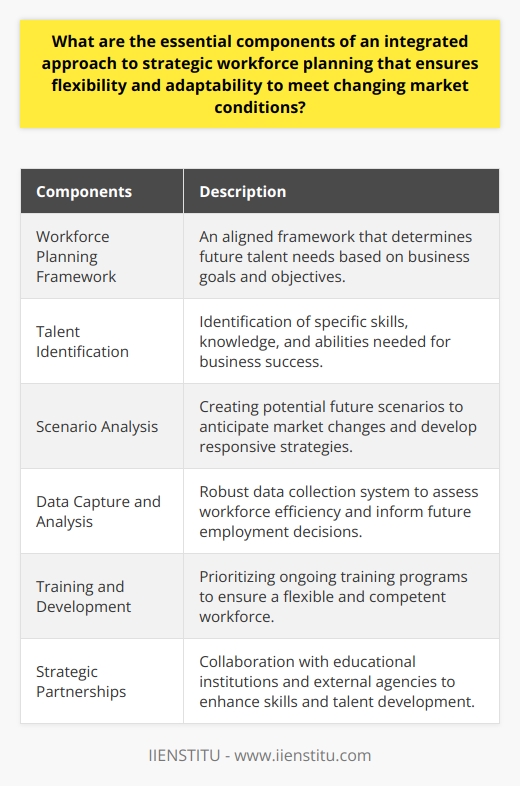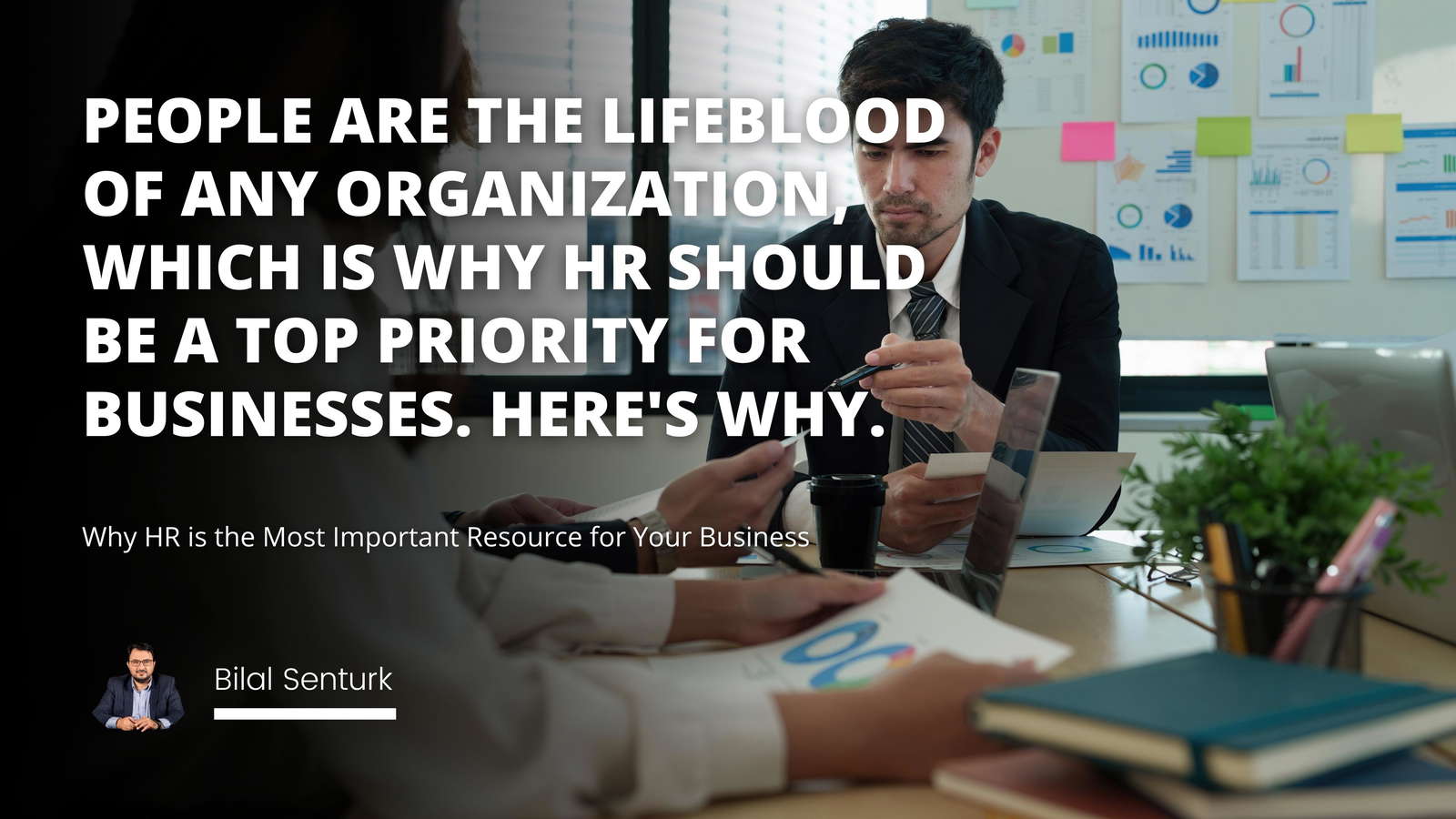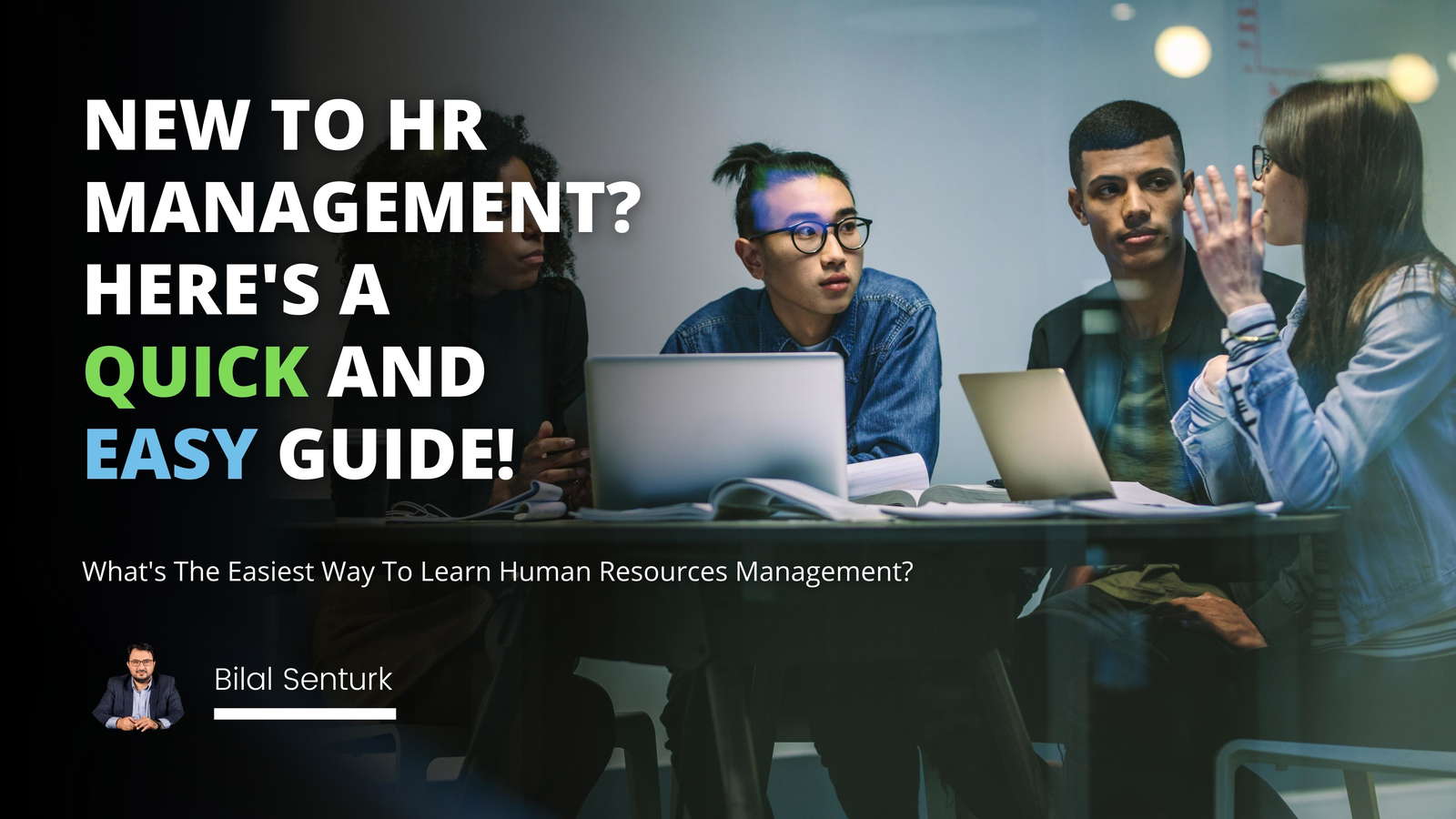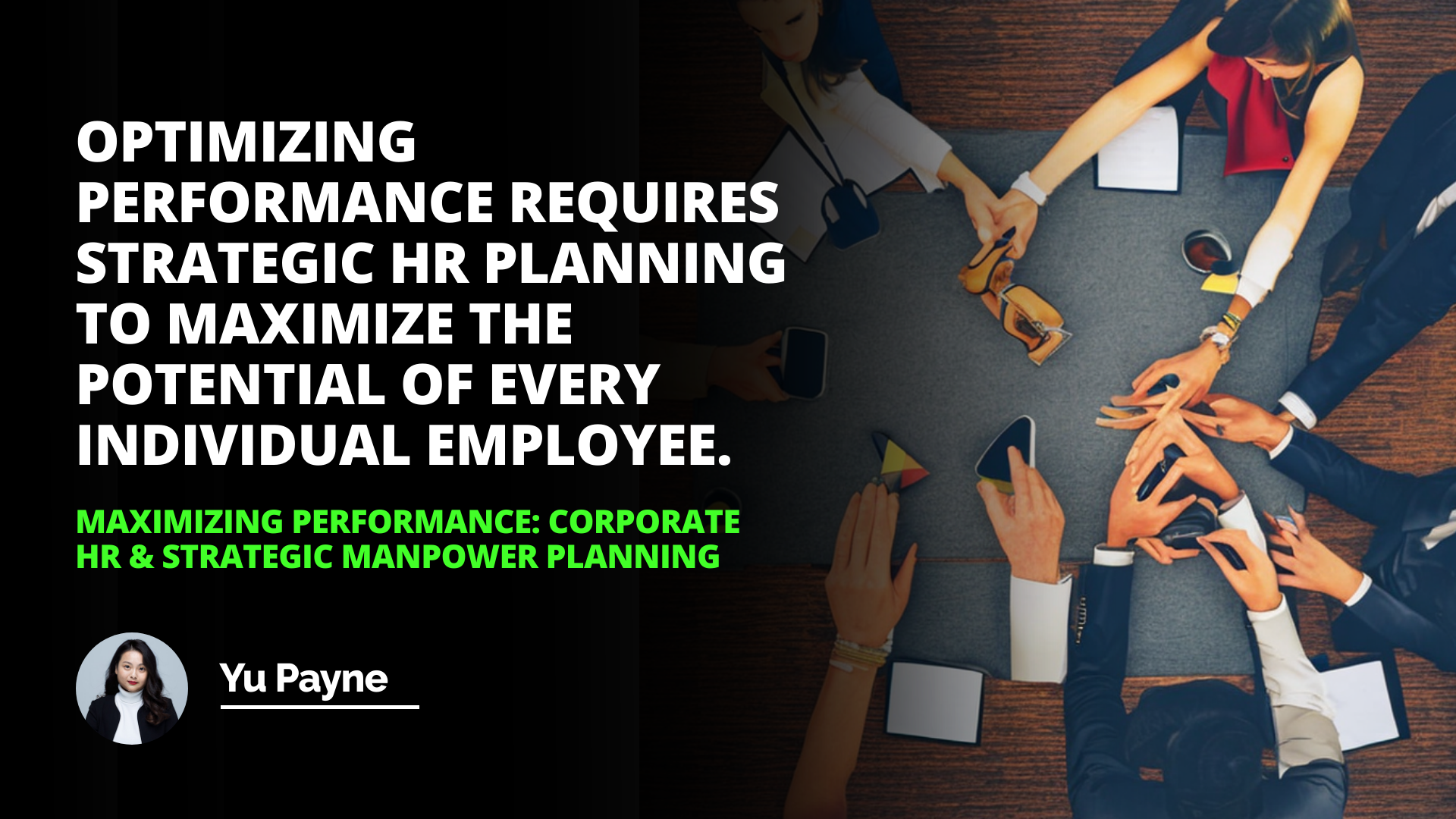
Definition of Strategic Manpower Planning
Overview of Corporate HR
Examining Barriers to Corporate HR & Strategic Manpower Planning
Understanding How to Maximize Performance through Corporate HR & Strategic Manpower Planning
Exploring Successful Practices & Examples
At the heart of an organization’s success lies the ability to match its goals and objectives with the right people, processes, and resources. The two essential tools in enabling an organization to effectively deliver on its goals and embrace the ever-evolving business environment are corporate HR and strategic workforce planning.
Definition of Strategic Manpower Planning
At its core, strategic workforce planning (SMP) is the process of proactively managing and investing in people resources to ensure the successful operation of a business. It is a vital link between the business’s strategy and its ability to execute. By carefully selecting, accessing, and utilizing the organization’s human resources, SMP ensures that the right people are in the right roles at the right time.
Overview of Corporate HR
Corporate HR provides and supervises the benefits, policies, and services an organization offers its employees and the wider public. It is an essential element of an organization’s Human Capital Management function. In addition, corporate HR activities help to shape an organization’s culture, values, and goals by supporting recruitment, developing individual and team performance, and nurturing a diverse and inclusive workplace.
Examining Barriers to Corporate HR & Strategic Manpower Planning
Despite the importance of corporate HR and strategic workforce planning, several barriers exist to successfully implementing these practices. One of the most common barriers is the lack of an accurate job profile for each role, limiting the ability to match people with the right jobs accurately. Other barriers can include a lack of alignment between the organization’s goals and the individual employee, a lack of understanding of the importance of these practices within the organization, difficulty building trust between senior management and employees, and a lack of suitable and accessible training opportunities.
Understanding How to Maximize Performance through Corporate HR & Strategic Manpower Planning
To maximize performance and ensure that a business is set up for success, the following steps should be taken into consideration:
Set clear goals and objectives. Ensure the goals and objectives of the business are well communicated and understood by all stakeholders.
Establish accurate job profiles. Develop detailed job profiles to match individuals with roles accurately.
Align employee goals with the organization’s objectives. Ensure that every employee understands the organization’s goals and objectives and how their individual goals and objectives fit with this.
Offer incentives and rewards. Reward employees for reaching performance targets and promote team activities that encourage collaboration and creativity.
Make use of the latest technology to sustain employee productivity. Ensure that the organization keeps up with the latest trends and technology to maintain a competitive edge and create an attractive working environment.
Foster an open culture of communication. Encourage open dialogue and collaboration between employees, management, and other stakeholders to ensure that issues and ideas can be addressed effectively.
Exploring Successful Practices & Examples
Several organizations have successfully implemented corporate HR and strategic workforce planning to maximize performance. Microsoft, for example, places a strong emphasis on employee engagement in its workforce and its approach to strategic planning. It fosters an open culture of communication where ideas and constructive feedback are actively encouraged. Alternatively, Google strongly emphasizes its people-centric approach to productivity and performance. It has developed several best practices, such as flexible working arrangements and wellness programs, to foster a productive and motivated workforce continuously.
Conclusion: Corporate HR and strategic workforce planning have the potential to improve organizational performance significantly. Organizations should ensure clear goals, accurate job profiles, and an open communication culture to ensure success. In addition, organizations should explore modern technologies such as flexible working arrangements and wellness programs to provide the best chance of success. By taking these steps, organizations can ensure that their human resources are effectively aligned with their goals and objectives, resulting in greater efficiency and increased performance.
Optimizing performance requires strategic HR planning to maximize the potential of every individual employee.
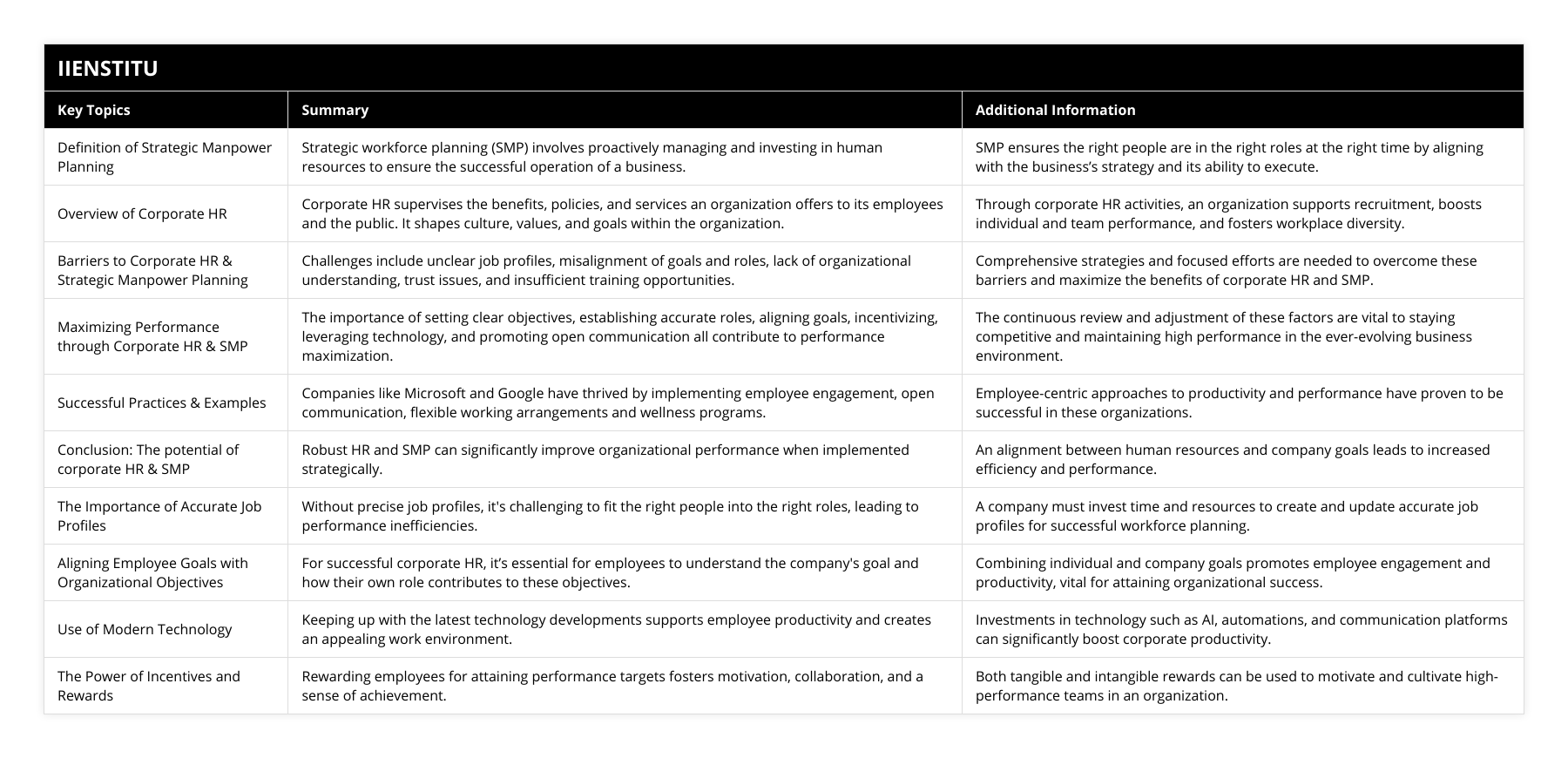
Frequently Asked Questions
What strategies can be used to maximize performance through corporate HR & strategic manpower planning?
Human resource planning is a critical component of any corporate strategy, designed to ensure the continued success and growth of the organization. Therefore, executives and managers must be vigilant to maximize performance by utilizing effective methods and tools to improve the processes involved in corporate HR and strategic workforce planning.
One key to improving performance associated with corporate HR and strategic workforce planning is to assess and evaluate the current organizational structure and staff. By understanding the roles and responsibilities of the current workforce, managers may identify areas in which improvements may be made, such as increasing efficiency, improving communication, and streamlining processes. Additionally, analyzing employee engagement and performance can help identify areas and opportunities for growth.
Another strategy to maximize performance is to invest in developing employees' skills and knowledge, which may be accomplished through team-building exercises, mentoring, and training programs. Such methods can create an environment conducive to optimal performance by providing employees with the support and direction they require to succeed. Additionally, this may reduce costs associated with employee turnover and enhance employee morale and engagement.
In addition to training and development, providing incentives and rewards can also be an effective strategy for boosting employee performance. For example, companies can implement financial, recognition, or time off incentives that recognize excellent performance and thus encourage employees to strive for high achievement. Additionally, creating an atmosphere of fairness and equality in pay and working conditions can help to foster an environment of collaboration, responsible accountability, and admiration.
Finally, managers must create supportive cultures focusing on innovation and learning. Such cultures should be values-driven, offering opportunities for employees to succeed and, in turn, for the organization to perform at a higher level. By creating a culture of collaboration, creativity is encouraged, productivity increases and employees are more likely to remain with the organization, further improving the organization’s long-term success.
In conclusion, organizations must implement effective strategies and tools associated with corporate HR and strategic workforce planning to maximize performance. Such a process should involve assessing and evaluating the current organizational structure and staff, investing in developing the skills and knowledge of employees, using incentives and rewards, and creating an environment of innovation and learning. Ultimately, these strategies can substantially improve performance and bolster competitive advantage.
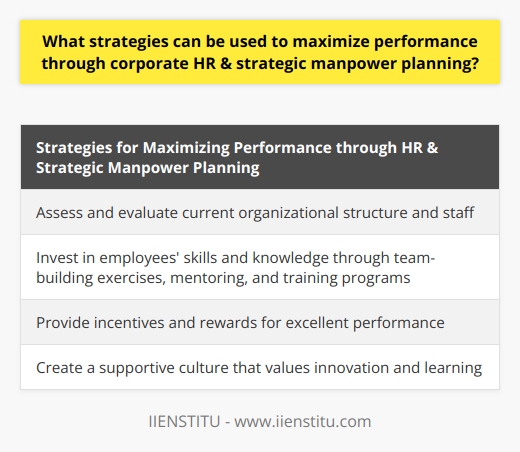
How can corporate HR & strategic manpower planning be used to increase effectiveness and efficiency in the workplace?
Organizations rely on effective human resources management to ensure their operations run smoothly. Effective HR management involves various activities, ranging from recruiting and hiring the right people to provide benefits and managing conflicts. However, the increasing complexity of the business environment has necessitated the development of more proactive measures to ensure that the organization’s workforce is adequately addressed. This is where corporate HR and strategic workforce planning (SMP) come into play.
Corporate HR is a holistic approach to HR management that fosters trust and mutual respect between employees and managers. Furthermore, it seeks to align HR activities with the organization's overall aims and ensure that personnel policies and practices align with the firm’s vision and objectives. Through this holistic approach, corporate HR enables organizations to understand their workforce, identify areas for improvement and make informed decisions that result in cost savings, increased efficiency, and improved quality of service.
On the other hand, SMP is a systematic approach to analyzing and forecasting the number of employees required and their skill sets that meet the organization’s future objectives. It involves establishing the organization's goals, analyzing future changes in workforce size and skill sets, and devising strategies and policies to address them. SMP aims to ensure that the organization has the correct number and mix of employees to meet current and future business needs.
The combination of corporate HR and SMP can be a powerful tool to ensure effectiveness and efficiency in the workplace. Through corporate HR practices, firms can improve employee engagement and foster a culture of trust and mutual respect. This enables organizations to create a better workplace environment and extract more value from their workforce. Meanwhile, SMP provides the knowledge and insights needed to ensure that the organization has the correct number and mix of personnel to meet its existing and future needs. This helps the organization to avoid any costly over- or understaffing.
Overall, corporate HR and strategic workforce planning can be instrumental for firms seeking to increase workplace effectiveness and efficiency. By leveraging these tools, organizations can better understand their workforce, identify areas for improvement and devise policies and strategies that ensure the correct number and mix of personnel for the organization’s goals. It is an essential component of any successful organization’s HR strategy.
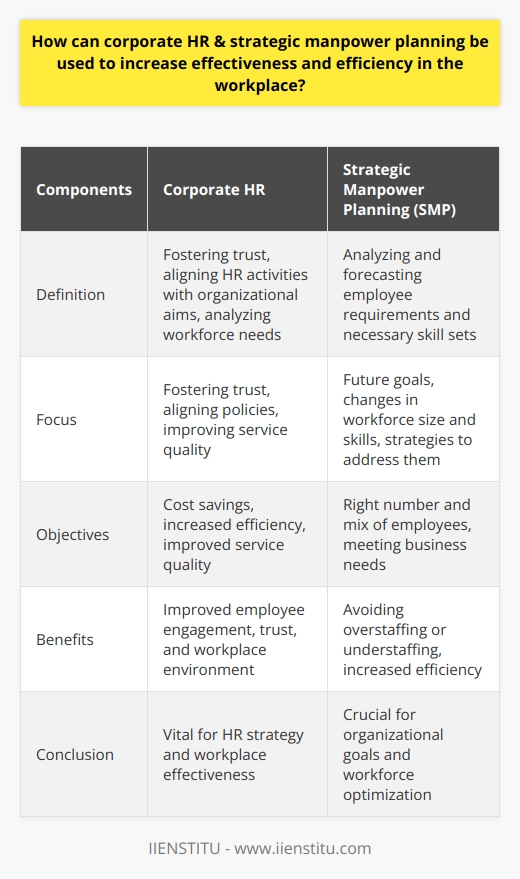
What techniques can be utilized to ensure alignment between human resource planning and organizational objectives?
Human resources (HR) are a fundamental part of any organization, and without careful planning to ensure alignment between objectives, a business can struggle. Effective HR planning ensures that organizational goals are achieved efficiently and effectively. Ensuring alignment between HR planning and corporate objectives requires a few essential techniques.
The primary way to ensure that HR is well-aligned with organizational objectives is to create an HR plan consistent with the organization's goals. To do this, an organization should first analyze its existing HR structure and policies, then identify the gaps between where they are and the skills and abilities they need to reach its objectives. Once the holes have been placed, the HR team can develop a clear plan to address the identified gaps and any shortfalls, ensuring that the program is consistent with the organization's objectives. Additionally, the HR plan should ensure that there is a sufficient number of personnel with the required skills, as well as that all employees are adequately trained for their roles.
Another way to ensure alignment between HR planning and organizational objectives is to consider the impact of any changes that are implemented carefully. Organizations need to consider any potential future changes before making a decision. This will allow them to determine the best action before making lasting changes. Additionally, organizations should utilize external experts to evaluate their HR strategy and recommend changes, as they can provide an unbiased opinion on how the changes will affect organizational objectives.
Finally, organizations should continually monitor and review their HR plan. Regular reviews will ensure that any changes are consistent with the organization's objectives or that any potential changes remain necessary to the overall plan. This will also monitor the effectiveness of the HR plan, allowing them to make changes as needed along the way.
In conclusion, a few techniques can be utilized to ensure alignment between HR planning and organizational objectives. These techniques include creating an HR plan consistent with corporate goals, considering the impact of any changes, and conducting regular reviews of the HR plan. When these techniques are implemented and followed, organizations will be better equipped to ensure that their organizational objectives are met.

What is the role of HR in workforce planning?
Role of HR in Workforce Planning
Identification of Organizational Needs
The HR department's first role in workforce planning involves identifying the organization's current and future needs. HR professionals collaborate with other departments to understand ongoing and potential projects and assess the skills required. This requires an in-depth understanding of the organization's strategic goals to ensure available personnel matches the business's growth and shifting priorities.
Demand and Supply Analysis
HR departments subsequently conduct a demand-supply analysis that helps assess workforce gaps. This involves estimating the demand for human resources and comparing it against the supply within the company. By doing so, HR professionals can identify workforce shortages or surpluses and address them accordingly.
Recruitment and Selection
Once the needs and gaps have been identified, the HR department ensures the recruitment and selection of appropriate candidates to fill vacant positions. This involves using different recruitment strategies to source the best talent and selecting individuals who possess the skills, knowledge and competencies needed to contribute to the organization's objectives.
Workforce Development
In addition to hiring new staff, HR plays a crucial role in workforce development. This includes employee training, talent management, succession planning, and leadership development programs. HR professionals assess the organization's needs to create and implement effective solutions to enhance the workforce's overall performance.
Employee Retention
Staff retention is a vital aspect of workforce planning. HR professionals implement retention strategies to ensure that valuable employees stay with the organization. These strategies include competitive compensation packages, employee engagement, performance management, and work-life balance initiatives.
Continuous Evaluation and Adaptation
Lastly, HR departments must continuously evaluate and adapt workforce planning strategies to keep up with changes in the business environment, regulatory landscape or technological advancements. Regular audits of workforce planning processes are necessary to identify areas for improvement and accommodate any challenges, ensuring the organization remains competitive and excels in its industry.
In conclusion, the role of HR in workforce planning is multi-faceted and integral to an organization's success. Through identification, analysis, and addressing workforce needs and gaps, HR professionals contribute to the organization's strategic goals, create a competitive edge, and build a sustainable and productive workforce for the future.
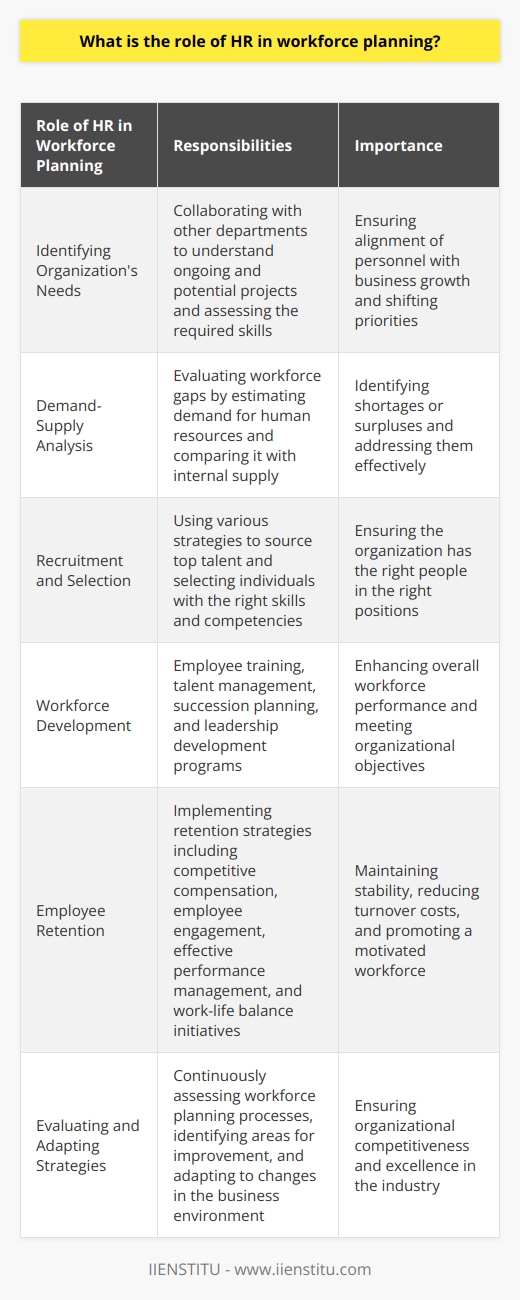
What are the 5 key elements of workforce planning?
**Understanding Workforce Planning**
Workforce planning plays a critical role in ensuring organizations have the proper human resources to achieve their strategic goals. The five key elements of workforce planning include analyzing current workforce, identifying future workforce needs, gap analysis, developing action plans, and monitoring progress.
**Analyzing Current Workforce**
The first element involves evaluating the current workforce's skill sets, knowledge, and capabilities. Organizations must conduct a thorough analysis of their employees' strengths, weaknesses, and potential for growth. This process aids in identifying areas needing improvement or attention and determining if the current workforce aligns with organizational objectives.
**Identifying Future Workforce Needs**
The second element involves anticipating the organization's future workforce requirements to reach strategic goals. This includes anticipating and planning for changes in the organizational structure, industry trends or technological advancements, and regulatory requirements. By identifying these needs, organizations can proactively develop staffing plans to meet projected demands, maintain a competitive edge, and reduce the risk of skills shortages.
**Gap Analysis**
The third element is conducting a gap analysis to identify discrepancies between the existing workforce's competencies and the organization's future needs. This involves evaluating the current workforce capabilities against projected requirements and building a comprehensive understanding of any existing or imminent labor gaps. This information is crucial for informing targeted development and recruitment strategies, addressing workforce gaps, and creating a more adaptable, agile workforce.
**Developing Action Plans**
The fourth element involves developing strategic action plans to address identified workforce gaps and align human resources with organizational objectives.Action plans may include recruitment, staff development, succession planning, or retention strategies. A well-defined action plan provides a clear roadmap and framework for achieving the organization's desired outcomes through effective workforce management.
**Monitoring Progress**
The final element is the ongoing evaluation of action plans and workforce planning strategies to ensure their effectiveness in achieving intended goals. Monitoring progress is essential for identifying areas of success, determining areas requiring improvement or adjustment, and ensuring organizational adaptability in the face of evolving workforce or industry conditions. Regular progress assessments can improve the likelihood of long-term workforce and organizational success.
In conclusion, effective workforce planning is a critical aspect of human resource management that successfully navigates the challenges and opportunities of the future. Incorporating these five key elements into workforce planning will provide organizations the insights and strategies required to bridge skill gaps, maintain competitiveness, and achieve long-term success.
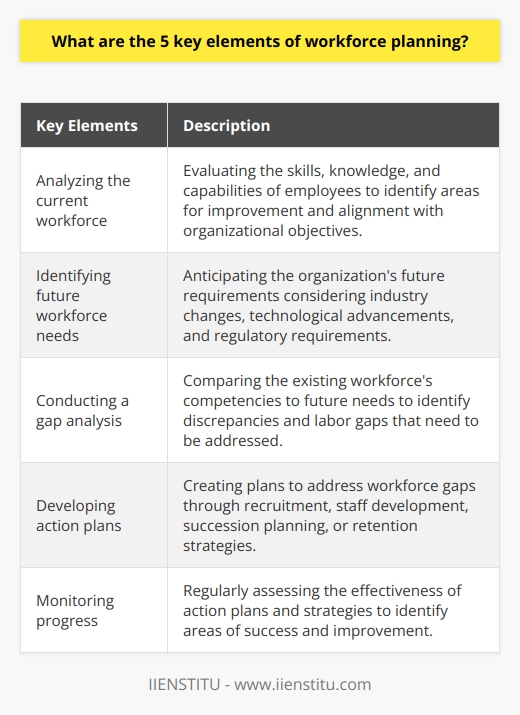
How can HR get better at strategic workforce planning?
**Understanding the Business Context**
HR can enhance strategic workforce planning by deeply comprehending the organization's industry, business model, and potential future needs. By regularly studying market trends and emerging technologies, HR professionals can anticipate potential skill requirements and labor market changes. This understanding allows them to create responsive workforce plans that support the organization's long-term objectives.
**Aligning with Organizational Goals**
One crucial aspect of fostering better strategic workforce planning is ensuring that HR initiatives align with organizational goals. HR professionals should engage in conversations with executive leadership and functional departments to understand the organization's short and long-term objectives better. With this knowledge, they can craft effective workforce plans aimed at meeting these goals and driving sustainable growth. Collaboration with other departments can also help HR identify and address employees' skills gaps, increasing overall performance.
**Leveraging Data Analytics**
HR professionals can significantly improve strategic workforce planning by employing data analytics to inform talent decisions. Analyzing workforce data can provide insights into employee turnover, skills gaps, and productivity levels. By interpreting these patterns, HR can identify potential issues and develop targeted interventions to mitigate talent risks. Additionally, data analytics can lend an evidence-based approach to hiring, promotion, and retention decisions, yielding more effective strategies for workforce development.
**Focus on Talent Development**
To get better at strategic workforce planning, HR can adopt a proactive approach to talent development. This involves creating comprehensive employee development plans, nurturing skills through training, mentoring, and knowledge transfer programs, and identifying employees with high potential for leadership and growth. A strong talent development framework enables HR to prepare the workforce for future challenges, ensuring the right mix of skills and abilities are available internally.
**Evaluating and Adapting HR Strategies**
An essential component of successful strategic workforce planning is maintaining a continuous improvement mindset. HR professionals should frequently assess the effectiveness of their strategies, identifying areas of success, and opportunities for further development. This evaluation process may involve analyzing key performance indicators, soliciting feedback from employees and stakeholders, and benchmarking HR initiatives against industry best practices. Through a consistent process of evaluation and adaptation, HR can improve its strategic workforce planning capabilities over time.
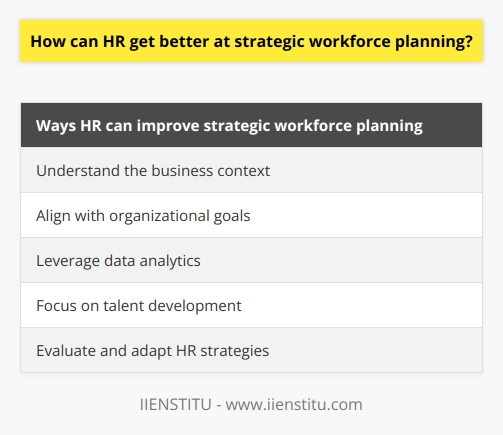
What is the relationship between strategic workforce planning and organizational success?
Relationship Between Strategic Workforce Planning and Organizational Success
Understanding Strategic Workforce Planning
Strategic workforce planning is a systematic process implemented by organizations to identify and address potential gaps in their existing workforce. This is done by evaluating the workforce's current capabilities and future needs to ensure that the organization can efficiently and effectively achieve its goals. It is an essential tool for understanding the present workforce landscape and predicting future requirements.
Impact on Organizational Success
Numerous studies have shown a strong connection between effective strategic workforce planning and organizational success. This approach enables organizations to be proactive, rather than reactive, by anticipating potential workforce obstacles and developing strategies to overcome them. With a well-planned workforce, organizations can ensure that they have the right combination of skills, experience, and expertise available to meet their strategic objectives.
Enhancing Business Agility
Implementing strategic workforce planning can also boost a company's agility. Organizations that can quickly anticipate and adapt to changing market conditions, shifting customer preferences, and technological advancements are more likely to succeed. By identifying and addressing potential talent gaps, strategic workforce planning empowers organizations to respond to evolving demands, thus maintaining a competitive edge in their respective industries.
Promoting Employee Retention
Another crucial ingredient of organizational success is employee retention. By identifying the right talent for the right role, strategic workforce planning enables organizations to offer employees opportunities that align with their skills and aspirations. This, in turn, fosters job satisfaction and loyalty. By retaining high-performing employees and minimizing staff turnover, organizations can benefit from consistent performance and reduced hiring and training costs.
Facilitating Effective Leadership Development
Effective leadership is paramount to an organization's success, and strategic workforce planning plays a critical role in identifying and nurturing future leaders. It allows organizations to spot high-potential employees early in their career and provide them with the necessary training and development opportunities to excel in leadership roles. Investing in leadership development can significantly impact an organization's ability to achieve its objectives and remain competitive.
In conclusion, strategic workforce planning contributes significantly to an organization's success by enhancing business agility, promoting employee retention, and facilitating effective leadership development. A carefully designed and implemented strategic workforce plan can empower organizations to navigate challenges, seize opportunities and maintain a competitive edge within their industry.
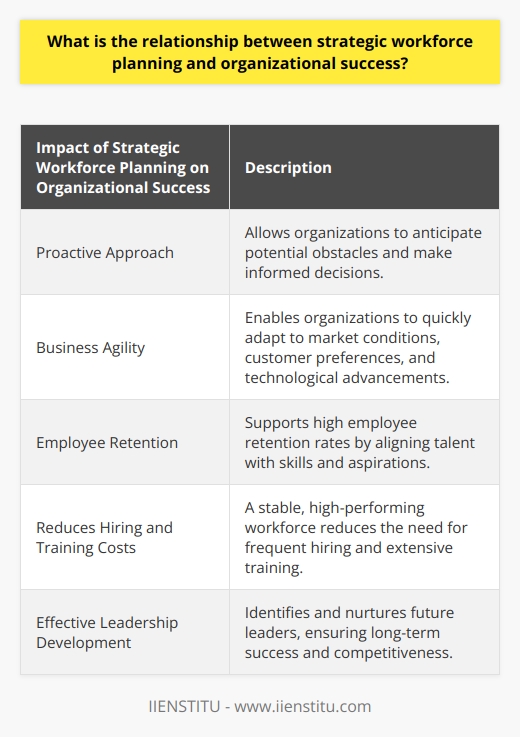
How can organizations effectively integrate workforce planning with long-term business goals?
Organizational Alignment
To effectively integrate workforce planning with long-term business goals, organizations must first ensure that their human resources (HR) and strategic planning departments are aligned. This alignment involves the HR department working closely with the management team to clearly understand the organization's vision, mission, and goals. By understanding these aspects, the HR department can develop and implement workforce strategies that help to achieve these overall objectives.
Skill Development
Another important factor is the development of the employees' skills and knowledge required for the organization to achieve its goals. By identifying the skills necessary to meet projected growth, the HR department can focus on providing training and development opportunities for the workforce. This not only benefits the organization in the short-term by improving employee performance but also helps to ensure that the organization has the skills required to achieve long-term success.
Succession Planning
An additional consideration in integrating workforce planning with long-term business goals is the implementation of succession planning. Organizations must identify and develop potential successors for important roles within the organization. This is essential for maintaining a continuous pipeline of leadership talent necessary for achieving long-term growth and success. By identifying employees with the potential to fill key positions and providing them with the necessary development opportunities, organizations can ensure a smooth transition of leadership as the business continues to evolve.
Monitoring and Evaluation
Lastly, organizations should incorporate regular monitoring and evaluation processes into their workforce planning strategies. This involves reviewing the effectiveness of the workforce strategies in achieving the organization's overall objectives. By consistently evaluating the success of workforce planning initiatives and making data-driven adjustments as needed, organizations can ensure that their strategies continue to contribute effectively to their long-term goals. In addition, by incorporating employee feedback and tracking key performance metrics, organizations can fine-tune their workforce planning efforts and ensure that the needs and expectations of employees are met.
In conclusion, effectively integrating workforce planning with long-term business goals requires a strong alignment between the HR department and organizational leadership, a focus on employee skill development, deliberate succession planning, and consistent monitoring and evaluation of workforce planning initiatives. By addressing these key factors, organizations can build a strong foundation for achieving their long-term objectives while maintaining a competitive advantage in the market.

What are the best practices in implementing a comprehensive and strategic approach to human resource planning and management?
Defining the Objectives
To implement a comprehensive and strategic approach to human resource planning and management, it is essential to begin by defining clear objectives. The organization must establish goals based on current and future needs, ensuring alignment with overall business strategy.
Conducting a Gap Analysis
Next, a gap analysis can help identify any disparities between current workforce capabilities and future requirements. This process includes assessing existing skills, experience, and competencies, as well as forecasting future workforce needs and identifying opportunities for development and growth.
Developing a Workforce Strategy
Following the gap analysis, a workforce strategy should be developed to achieve the established objectives. This includes selecting appropriate techniques to attract, develop, and retain talent, such as recruitment, training and development, performance management, and succession planning.
Incorporating Diversity and Inclusion
Incorporating diversity and inclusion in human resource planning and management is a best practice that leads to better organizational performance. A diverse and inclusive workforce promotes innovation, fosters creativity, and improves decision-making, ensuring the organization stays competitive in the market.
Utilizing Technology and Data
Leveraging technology and data is essential in modern human resource management. Utilizing HR software, analytics, and data-driven decision-making allow organizations to make informed decisions, optimize processes, and improve overall efficiency in workforce management.
Fostering Collaboration and Communication
Effective communication and collaboration among HR professionals, management, and employees is critical to successful human resource planning and management. Establishing a culture of transparency and open dialogue promotes employee engagement, fosters a better understanding of organizational goals, and ensures successful implementation of HR strategies.
Monitoring and Evaluation
Finally, a continuous process of monitoring and evaluation is vital to ensure successful implementation of HR strategies and to identify areas for improvement. Regularly assessing the effectiveness of HR practices helps organizations adapt and evolve as necessary, maintaining alignment with organizational objectives and responding to changing workforce needs.
In conclusion, the best practices in implementing a comprehensive and strategic approach to human resource planning and management include clearly defining objectives, conducting gap analysis, developing a workforce strategy, incorporating diversity and inclusion, utilizing technology and data, fostering collaboration and communication, and consistently monitoring and evaluating HR practices. These practices promote optimal organizational performance, enabling businesses to achieve their goals and maintain a competitive advantage in the market.
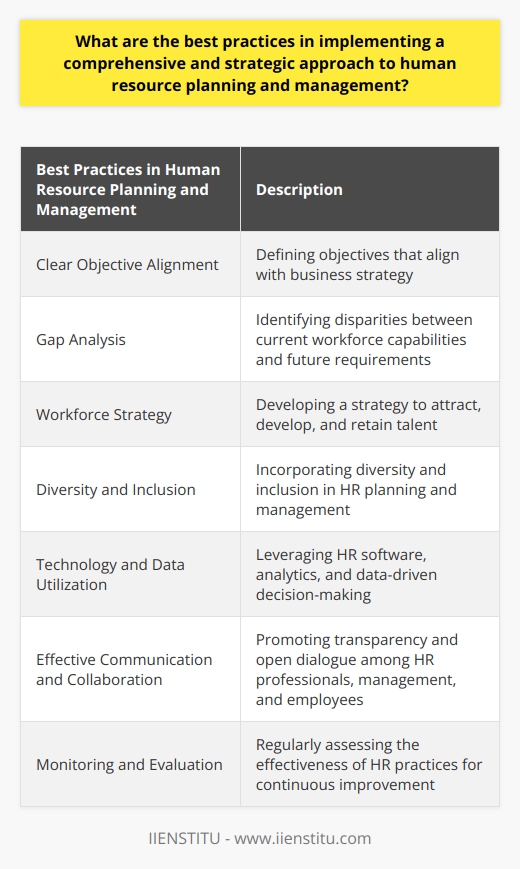
What is the relationship between strategic manpower planning and corporate strategy?
Relationship Overview
The relationship between strategic manpower planning and corporate strategy is a critical aspect that determines the success of an organization. Strategic manpower planning involves forecasting the human resource needs of an organization in alignment with its overall goals and objectives. It considers factors such as recruitment, employee diversity, and talent development to ensure the optimum utilization of human resources.
Integration with Corporate Strategy
Strategic manpower planning integrates with corporate strategy by identifying the required workforce for achieving the organization's vision and mission. This connection ensures that an organization has the right employees in the right positions to match its strategic direction. By considering the existing human resources and future needs, strategic manpower planning helps organizations address skill gaps, making them better equipped to execute their corporate strategy.
Role of Skills and Competencies
Skills and competencies play a vital role in the relationship between strategic manpower planning and corporate strategy. For an organization to succeed in its strategic endeavors, it must ascertain the skills required for current and future endeavors. Assessments and evaluations of employees' skills and competencies enable organizations to develop and implement training programs that align with their corporate strategy.
Employment Flexibility and Adaptability
Another significant aspect of the relationship between strategic manpower planning and corporate strategy is the need for employment flexibility and adaptability. In today's dynamic business environment, organizations need to be agile and adaptive to remain competitive. By considering flexible work arrangements, remote work, and other non-traditional employment options, organizations can better align their manpower resources with their corporate strategy.
Workforce Development and Retention
Lastly, workforce development and retention are crucial elements in the relationship between strategic manpower planning and corporate strategy. High employee turnover can negatively impact an organization's ability to execute its corporate strategy effectively. Therefore, strategic manpower planning must consider employee engagement, growth opportunities, and retention initiatives for a stable and productive workforce that can propel the organization towards its strategic goals.
In conclusion, strategic manpower planning and corporate strategy are closely intertwined, with each influencing the other's effectiveness. Organizations that effectively align their human resource needs with their corporate strategy are better positioned to succeed in a competitive business environment. This alignment ensures that the right employees and skill sets are in place to execute the company's vision and achieve strategic objectives.
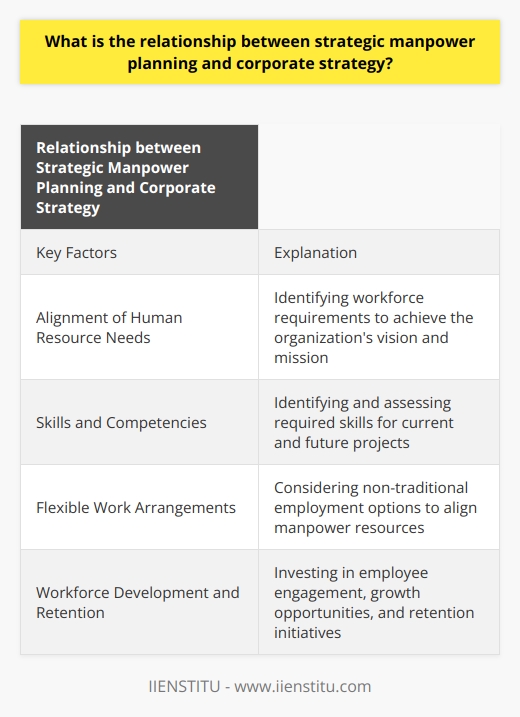
How do organizations align their workforce planning with changing market conditions and organizational objectives?
Workforce Planning and Market Conditions
Organizations must align their workforce planning with changing market conditions and organizational objectives to ensure competitiveness and sustainability. To achieve this alignment, they should follow several key steps.
Understanding Market Trends
First, organizations need to identify and monitor market trends to inform their workforce planning. This involves conducting regular market research, tracking economic indicators, and re-evaluating industry landscapes to identify opportunities and risks that may impact talent needs.
Setting Organizational Objectives
Second, organizations should establish clear, measurable objectives in response to shifting market conditions. These objectives should consider both short-term goals, such as meeting immediate talent requirements, and long-term objectives, such as developing employee skills to support future growth.
Mapping Workforce to Objectives
Next, organizations should map their existing workforce to these objectives by assessing employee skills, knowledge, and capacities. This process enables organizations to identify workforce gaps and areas in which employee development or recruitment is required to achieve their objectives.
Implementing Dynamic Strategies
Once these gaps are identified, organizations must implement dynamic workforce strategies that adjust to market conditions and organizational objectives. These may include targeted recruitment campaigns, re-skilling initiatives, or the redeployment of existing staff to better align with the organization's evolving needs.
Monitoring and Evaluating Progress
Finally, organizations should implement mechanisms to monitor and evaluate the effectiveness of their workforce planning efforts. This includes tracking key metrics, such as employee satisfaction, retention, and productivity, to determine whether their strategies are achieving the desired outcomes and contributing to the organization's overall success.
By following these steps, organizations can ensure that their workforce planning is effectively aligned with changing market conditions and organizational objectives, thereby maximizing their competitiveness and long-term sustainability.
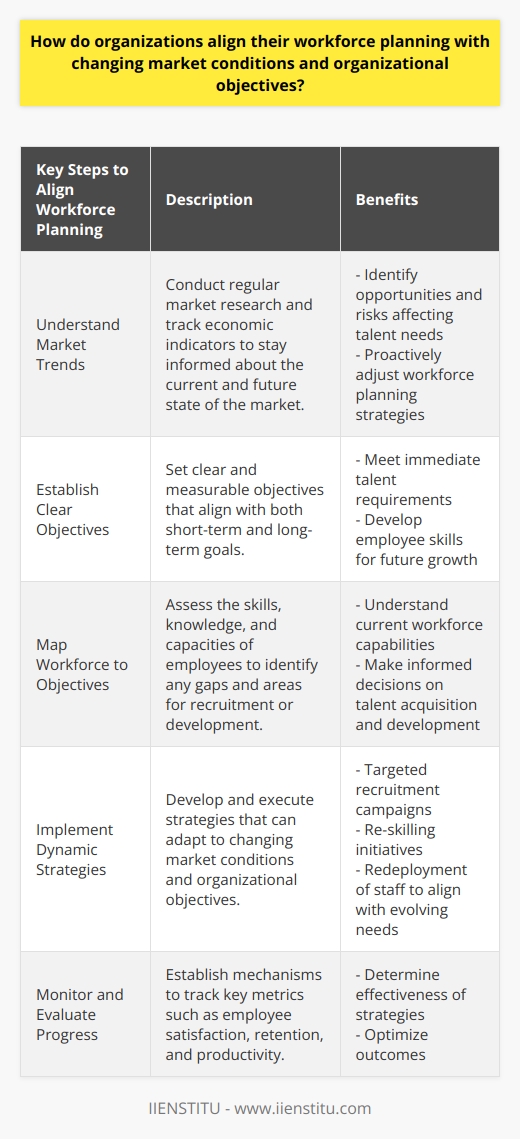
What factors should be considered when evaluating the effectiveness of an organization's manpower planning process?
Key Performance Indicators
The first factor to consider when evaluating the effectiveness of an organization's manpower planning process is to examine Key Performance Indicators (KPIs). KPIs offer measurable goals that assess a range of elements within the organization, such as employee productivity or turnover rates. Understanding the organization's KPIs can help inform decision-makers on how well the current manpower planning process is functioning and whether it aligns with corporate objectives.
Alignment with Organizational Goals
Another essential factor in evaluating the effectiveness of a manpower planning process would be its alignment with the organization's overall strategic goals and objectives. This alignment is crucial for successful workforce management as it ensures that the manpower planning process is designed to meet the organization's short and long-term needs. By understanding these goals and objectives, decision-makers can better assess how effective their current planning process is working.
External and Internal Factors
An organization's manpower planning process should also consider external factors, such as economic conditions, industry trends, and technological advancements. These external factors can potentially impact the organization's workforce and employment practices. Apart from external elements, the evaluation process should also consider internal factors, including operational efficiency, budget constraints, and company culture. Assessing both external and internal factors will help ensure a more robust and effective manpower planning process.
Training and Development Programs
Effective manpower planning should include an emphasis on employee training and development programs. These programs play a critical role in promoting employee productivity, engagement, and retention. By evaluating the organization's training and development strategies, decision-makers can determine if the current manpower planning process supports a continuous learning culture and if it contributes to long-term organizational success.
Retention and Recruitment Strategies
Finally, it is essential to assess the organization's retention and recruitment strategies when evaluating the effectiveness of the manpower planning process. Successful recruitment and retention of skilled employees is critical for maintaining organizational growth and competitiveness. Decision-makers should explore the efficacy of their existing strategies for talent attraction and retention, as well as the overall effectiveness of the organization's manpower planning process.
In conclusion, there are several factors that should be considered when evaluating the effectiveness of an organization's manpower planning process. These factors include alignment with organizational goals, understanding the organization's KPIs, considering external and internal factors, evaluating training and development programs, and assessing retention and recruitment strategies. By examining these elements, decision-makers can identify areas for improvement in their organization's manpower planning process to ensure long-term success.
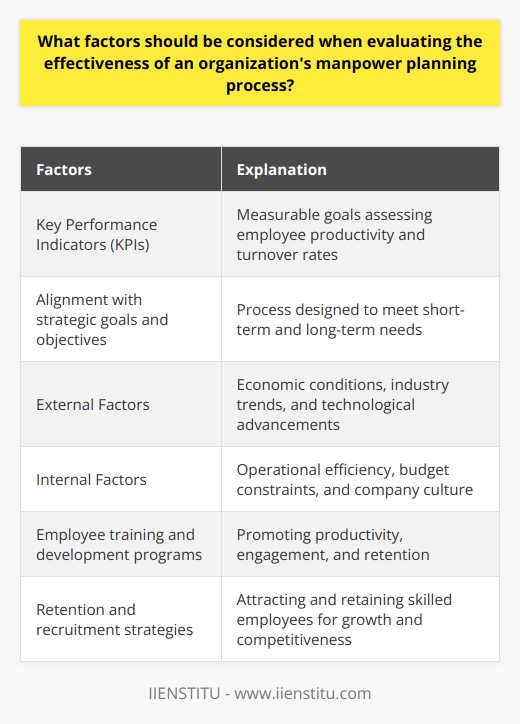
What are the key steps in strategic manpower planning?
**Identification of Organizational Goals**
The first step in strategic manpower planning involves the identification of an organization's long-term goals and objectives. This requires an understanding of the organization's mission, vision, and overall strategic plan. Analyzing the current and future needs of the organization helps in determining the necessary workforce requirements to achieve these goals.
**Skills Gap Analysis**
The next vital step is the skills gap analysis, which assesses the skills and competencies of the existing workforce. This identifies the key skill gaps that need to be addressed and helps in determining the type of talent to be recruited or developed internally through training and development initiatives. Regular skills assessments provide valuable insights into the organization's human capital status, allowing swift adjustments to meet evolving needs.
**Workforce Forecasting and Demand Analysis**
Workforce forecasting involves predicting the future workforce needs of an organization based on the strategic goals. This involves analyzing external factors, such as market trends, emerging industries, and overall economic conditions. Additionally, internal factors such as attrition rates, organizational growth, and employee productivity levels must also be considered. Through demand analysis, organizations can anticipate any potential shortages or surpluses in specific roles or talent areas.
**Talent Acquisition and Development Strategies**
Once the workforce requirements have been determined, organizations must focus on talent acquisition and development strategies. This involves sourcing and attracting candidates with the necessary skills and qualifications. Recruitment strategies must be aligned with the organization's long-term goals and the desired skills mix. Simultaneously, emphasis should be placed on developing existing employees through training, upskilling, and professional development programs.
**Succession Planning and Employee Retention**
An integral aspect of strategic manpower planning is succession planning, which involves identifying potential successors for leadership or critical positions to ensure business continuity. This requires developing employees to assume greater responsibilities through training and mentoring programs. Furthermore, employee retention plays a vital role in maintaining workforce stability and fostering a positive work environment. Organizations must, therefore, invest in employee engagement, career growth opportunities, and competitive compensation packages.
In conclusion, strategic manpower planning is a crucial function that enables organizations to meet their future workforce requirements effectively. By systematically identifying organizational goals, analyzing skills gaps, forecasting workforce demand, implementing talent acquisition and development strategies, and emphasizing succession planning and employee retention, organizations can ensure they remain competitive and successful in the dynamic business landscape.
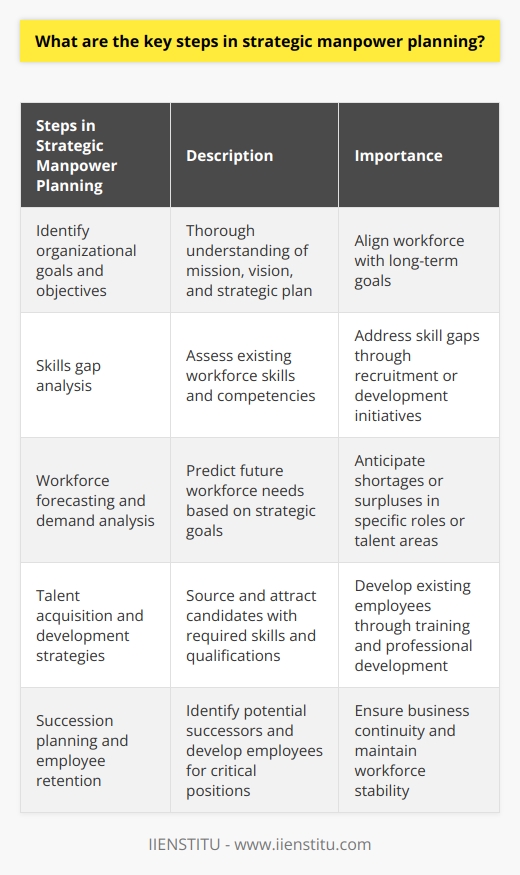
In the context of organizational success, what is the role of HR in workforce planning and corporate strategy?
Role of HR in Workforce Planning
Workforce planning is a crucial aspect of corporate strategy as it involves aligning the organization's human capital with its strategic goals. The Human Resources (HR) department plays a significant role in workforce planning, which includes talent acquisition, retention, and development. It is essential to ensure that the organization has the right people with the right skills and competencies to execute business strategies effectively.
Talent Acquisition and Management
First, HR is responsible for sourcing, selecting, and hiring employees who possess the necessary skills and qualifications to meet organizational requirements. It involves strategic talent sourcing methods, such as proactive recruitment, employer branding, and building relationships with universities and other institutions. Additionally, HR also manages the onboarding process, ensuring that new employees integrate effectively into the company culture.
Retention Strategies
Effective workforce planning also requires HR to focus on employee retention, addressing issues such as turnover, job satisfaction, and employee engagement. By implementing retention strategies, HR promotes a positive work environment, offering career and personal development opportunities, competitive compensation and benefits packages, and employee recognition. This way, the organization can retain its top talent while maintaining a motivated and engaged workforce.
Employee Development
Another critical aspect of HR's role in workforce planning is employee development. This process involves identifying skill gaps, providing training and development opportunities, and promoting a culture of continuous learning. HR professionals should establish a competency framework that aligns with the organization's strategic goals. They must collaborate with managers and employees to identify developmental needs, create customized training programs, and monitor progress.
Succession Planning
In workforce planning, HR must also focus on succession planning to ensure a continuous supply of qualified talent for key positions. This process involves identifying potential candidates, assessing their skills and competencies, and providing them with development opportunities to prepare them for future leadership roles. HR professionals can utilize performance management systems and establish leadership development programs to identify high-potential employees and groom them for succession.
In conclusion, HR plays a vital role in workforce planning and corporate strategy by ensuring organizations have the right talent in place to achieve strategic objectives. Through talent acquisition, retention strategies, employee development, and succession planning, HR professionals contribute significantly to organizational success. By integrating HR practices with corporate strategy, organizations can optimize their human capital, adapt to market changes, and maintain a competitive edge in the business world.
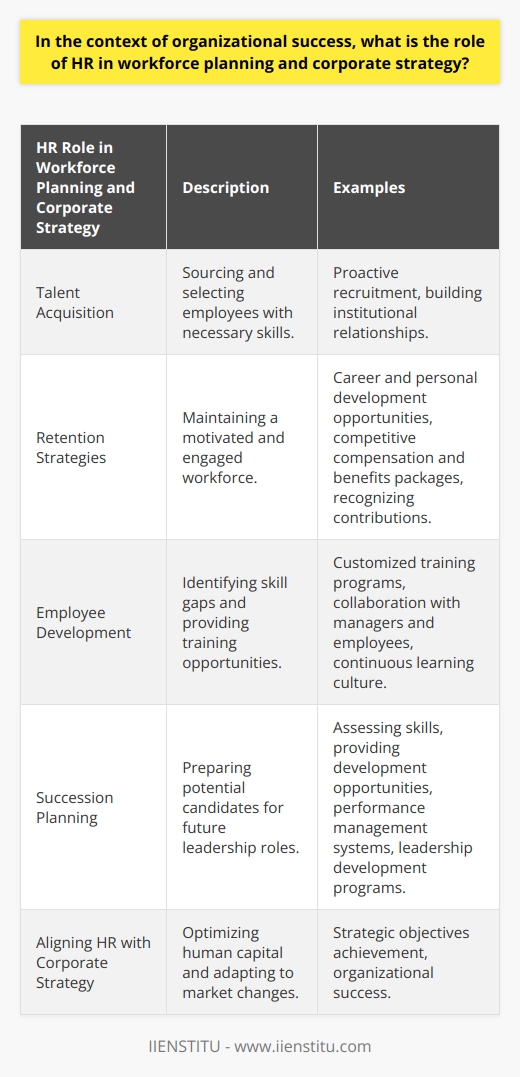
What are the essential components of an effective, integrated approach to workforce planning and long-term business objectives?
**Essential Components of Successful Workforce Planning**
An effective integrated approach to workforce planning and long-term business objectives requires a harmonious combination of various components. The main elements can be categorized as a thorough analysis of workforce requirements, efficient talent management, and maintaining organizational flexibility.
**Analyzing Workforce Requirements**
To begin with, organizations must develop a comprehensive understanding of their future workforce needs. This includes assessing the impact of technological advancements, changes in market conditions, and evolving socio-economic factors. Employers must also assess the skills, knowledge, and competencies needed to meet these future needs and align them with their long-term business strategy.
**Efficient Talent Management**
Effective talent management is vital to achieve long-term business objectives, as it enables organizations to acquire, develop, and retain the right people. Aligning talent management practices with workforce planning ensures that employees possess the necessary skills and capabilities to contribute to the company's long-term success. This includes identifying skill gaps, implementing training and development programs, and promoting a culture of continuous learning and development.
**Organizational Flexibility**
Lastly, maintaining organizational flexibility is key to adapt to the ever-changing business environment and remain competitive. It involves developing contingency plans to respond to unexpected workforce challenges, such as employee turnover or skills shortages. This also includes embracing workplace diversity, promoting cross-functional collaboration, and enabling remote work arrangements to foster resilience, innovation, and agility within the workforce.
In conclusion, an effective integrated approach to workforce planning and long-term business objectives demands a thorough analysis of workforce requirements, efficient talent management, and maintaining organizational flexibility. Emphasizing these essential components allows organizations to achieve their strategic goals and remain competitive in an ever-evolving business landscape.
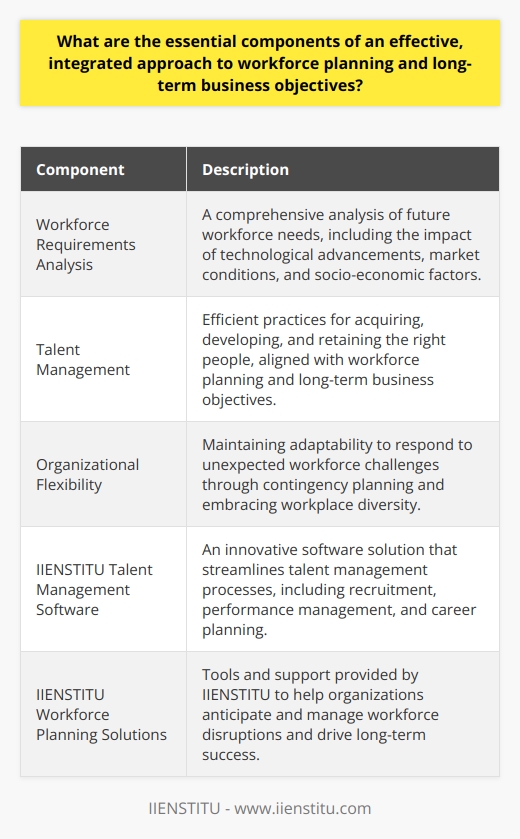
What is the relationship between workforce planning and the achievement of a company's long-term corporate strategy?
Understanding the Connection
Workforce planning is fundamentally linked to the achievement of a company's long-term corporate strategy. This is because it involves aligning the human resource needs with the strategic goals of the company.
Function of Workforce Planning
The main purpose of workforce planning is ensuring that a company has the right number of people with the right skills at the right times. These elements are paramount for operational efficiency, which is essential for achieving long-term corporate objectives.
Broad Scope of Planning
Workforce planning is comprehensive in nature. It covers aspects such as recruitment, training and development, talent management, succession planning, and retention. These aspects directly contribute to a company's capacity to execute its strategic plans effectively.
Aligning Workforce and Strategy
A company with a well-defined long-term strategic plan must match its workforce planning efforts with this strategic direction. This ensures maximum efficiency and effectiveness in the use of human resources for the attainment of corporate objectives.
The Importance of Skillset
Furthermore, understanding the necessary skillset for specific roles is another critical element in workforce planning. This could mean identifying gaps in skills and implementing measures to bridge such gaps which, in turn, supports strategic achievement.
Seeing the Bigger Picture
Overall, workforce planning forms a critical part of a company's strategic planning. Ensuring alignment between the two not only optimizes resource utilization, but also propels the company towards its long-term strategic objectives. Therefore, the strategic relevance of workforce planning in a company's corporate strategy cannot be overstated.
The Symbiotic Relationship
In conclusion, workforce planning and the achievement of a company's long-term corporate strategy are inextricably connected. One promotes the smooth operation and success of the other, demonstrating a symbiotic relationship that benefits the organization as a whole.
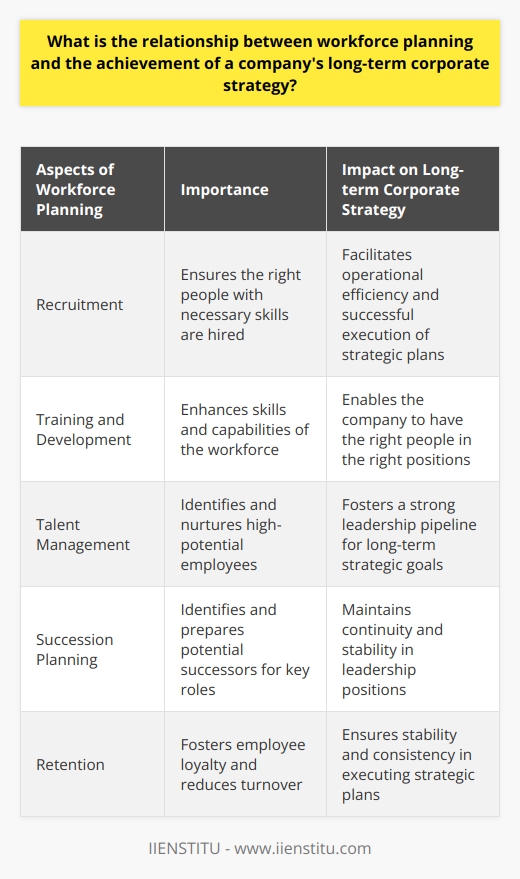
How can organizations effectively use strategic manpower planning to respond to fluctuations in market demand and labor supply?
Understanding Labor Market Dynamics
Organizations can leverage strategic manpower planning to adjust to market demand and labor supply dynamics effectively. They begin by recognizing supply and demand trends in the talent market. This insight aids in predicting imminent skills shortages or surpluses.
Proactive Approach in Workforce Planning
After identifying future labor market trends, organizations should take a proactive approach. They need to reassess projections regularly to allow timely adjustments. This proactive step ensures ample human resources to meet market demand.
Employing Predictive Analytics
Predictive analytics in manpower planning is a powerful tool. It offers valuable insights into potential future labor market scenarios. These insights can guide organizations in effectively managing their staffing levels.
Developing Competency Models
Developing competency models for key roles is pivotal for organizational readiness. These models outline the skills required to perform specific roles. They determine not only the number of employees needed but also the kinds of skills required.
Emphasizing Employee Development
One effective strategy is to prioritize the development of current employees. Investing in upskilling and reskilling can cater to future labor market needs. This strategy not only responds to shifts in labor supply but enhances employee retention.
Incorporating Flexible Staffing
Flexible staffing options, such as temporary or part-time staff, should not be overlooked. They can provide added adaptability in response to fluctuations in demand. They form a vital component in addressing immediate resourcing needs.
Promoting Strategic Talent Acquisition
Lastly, strategic talent acquisition plays a significant role. Organizations should tailor their recruitment strategies based on projected market demand and labor supply. Aligning recruitment with business objectives can yield enduring benefits.
In conclusion, strategic manpower planning is essential in adapting to market demand and labor supply fluctuations. Predictive analytics, competency modeling, employee development, flexible staffing, and strategic talent acquisition are crucial tactics to navigate such complexities.
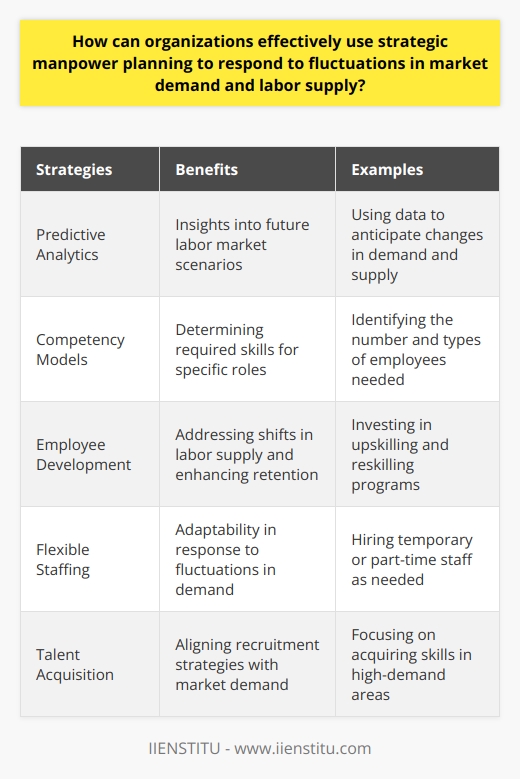
What are the 6 stages of workforce planning and how do they contribute to the overall success of an organization's human resource management?
Workforce Planning Process
The workforce planning process comprises six stages, each contributing to effective human resource management.
Identifying Future Needs
The first stage is identifying the organization's future needs. Understanding what will be required in terms of skills and labor over a decided timescale helps align recruitment efforts.
Environmental Scan
Next, organizations perform an environmental scan. Assessing both external and internal factors that could impact the workforce is crucial. Macro trends, market changes, legislation, and internal strategies all inform appropriate planning.
Workforce Gap Analysis
The third stage is a workforce gap analysis. Managers compare the current workforce's capabilities against future needs to identify any gaps. This information drives both hiring and training strategies.
Strategy Formulation
Strategy formulation comes next, which involves developing a plan to fill identified gaps. The strategies may include recruitment, reskilling current staff, or outsourcing tasks.
Implementation and Monitoring
The fifth stage involves implementing the plan and continually monitoring its effectiveness. All activities should be measured and analyzed to ensure they meet the organization's objectives.
Evaluation and Revision
Lastly, evaluation and revision are essential. Regular evaluations ensure the strategy is yielding the anticipated results. If not, businesses can revise the strategy and implementation plan accordingly.
These stages are cyclical and should be seen as a continuous process, always adapting to changing needs or circumstances. Thus, they contribute significantly to an organization's success by ensuring they have the right people, with the right skills, in the right places, optimizing productivity efficiency and enhancing the company’s competitive edge.
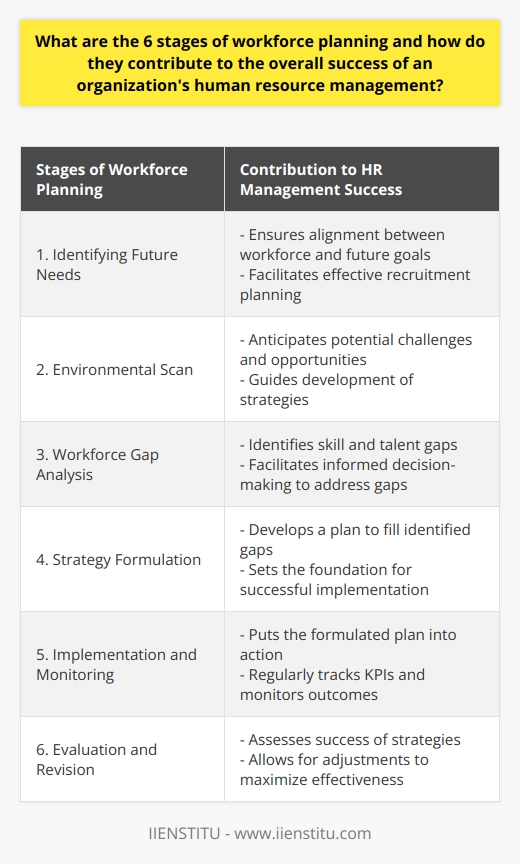
What are the 4 HR strategies and how do they contribute to successful workforce planning?
Human Resource (HR) Strategies for Successful Workforce Planning
HR strategies are key in managing human resources efficiently. They contribute significantly to successful workforce planning.
Defining HR Strategy
The first HR strategy involves defining the organization's human resource plan. It involves comprehensively understanding the workforce's skills and expertise and balancing these with the company's goals. Clear strategies aid in the hiring process, ensuring that every employee brings unique value.
Performance Evaluation Strategy
The second strategy is performance evaluation. Regular assessments provide an understanding of employees' skill levels and areas for improvement. This contributes to individual growth, which helps the employer fulfill the organization’s aims more effectively.
Learning and Development Strategy
Thirdly, a learning and development strategy. The goal is enhancing the skills of the workforce. Such strategies encourage an environment where employees can grow, ultimately increasing productivity and contribution to organizational success.
Compensation Strategy
Finally, the compensation strategy. This involves defining a suitable compensation and benefits structure. A fair and competitive structure is crucial for attracting and retaining top talent, greatly influencing long-term success.
Overall, HR strategies support effective workforce planning. They ensure the right people are in the right roles, effectively contributing to the company's progress. Notably, these strategies result in a workforce that is skilled, motivated, and closely aligned with the organization's targets. They are therefore instrumental in a company’s success.
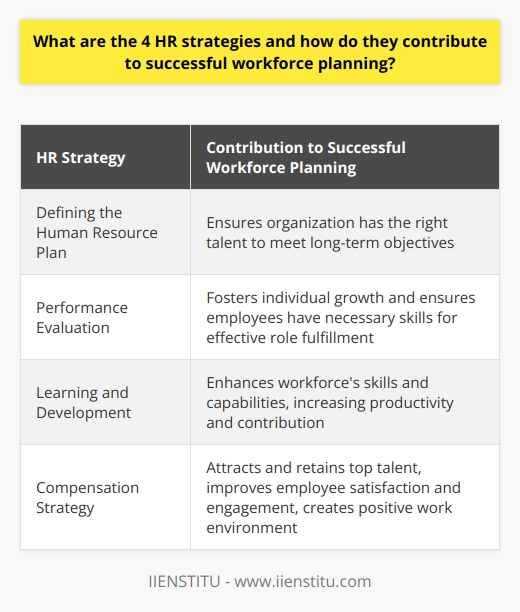
How can organizations align their manpower planning with technological advancements and their overall corporate strategy?
Effect of Technological Advancements on Manpower Planning
Organizations can use technology to enhance their manpower planning. This involves integrating technological advancements with the organization's strategic human resource practices. For example, HR software supports data analytics capabilities, predictive models, and machine learning algorithms.
Role of Alignment between Technology and Manpower
To achieve this alignment, organizations must ensure their corporate strategy considers technological advancements. This implies incorporating technology into the strategic planning process. Specifically, organizations should explore how technology can transform roles, workflows, and overall workforce productivity.
Considering Future Technological Trends
Incorporating future technology trends into manpower planning is also essential. Trends like artificial intelligence, automation, and data analytics can significantly influence job roles. Therefore, integrating these trends into manpower planning helps organizations prepare their workforce for upcoming changes.
Data-driven Manpower Planning
An effective method for aligning workforce planning with technology is through data-driven decision-making. Employing data analytics in HR processes can predict workforce trends, identify skill gaps, and ensure manpower planning is in line with business strategy.
Training and Development
Moreover, organizations should invest in training and development initiatives. This ensures employees continuously update their skills and knowledge according to technological advancements. Constant learning enables employees to use new technologies efficiently, thus aligning manpower planning with technological changes.
Hence, integrating technology in manpower planning involves strategic alignment, considering future technological trends, data-driven decision-making, and continuous training. In this way, organizations can align their manpower strategy with technological advancements and their overall corporate strategy.
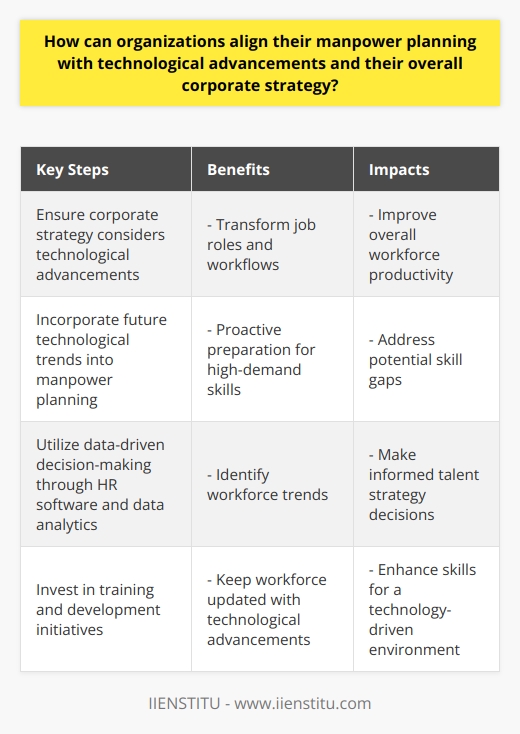
What are the essential components of an integrated approach to strategic workforce planning that ensures flexibility and adaptability to meet changing market conditions?
Workforce Planning Framework
A well-executed strategic workforce planning includes a workforce planning framework. This framework intricately aligns itself with business goals and determines future talent needs.
Talent Identification
Talent identification is pivotal. This involves identifying the skills, knowledge, and abilities required for the business. It helps to determine the necessary steps to attract and retain the desired talent.
Scenario Analysis
Scenario analysis is another essential component. It involves creating potential future scenarios. With these, organizations anticipate possible changes in market conditions and determine responsive strategies.
Data Capture and Analysis
Data capture and analysis is also crucial. A robust data collection system enables organizations to assess current workforce efficiency. Hence, it influences decision-making about the future employment model.
Training and Development
Focusing on training and development drives flexibility. Frequent capability development supports maintaining a competent and agile workforce. This approach aids in meeting rapidly changing market conditions.
Strategic Partnerships
Strategic partnerships with educational institutions or external agencies facilitate skill enhancement of the workforce. Such collaborations support talent development in line with the market dynamics.
Conclusion
Overall, an integrated workforce planning approach is a blend of comprehensive business understanding, diligent talent identification, prospective scenario planning, and data-driven insights combined with a robust training and an external partnership ecosystem. It ensures agility and adaptability to the changing market conditions, facilitating organizational success.
